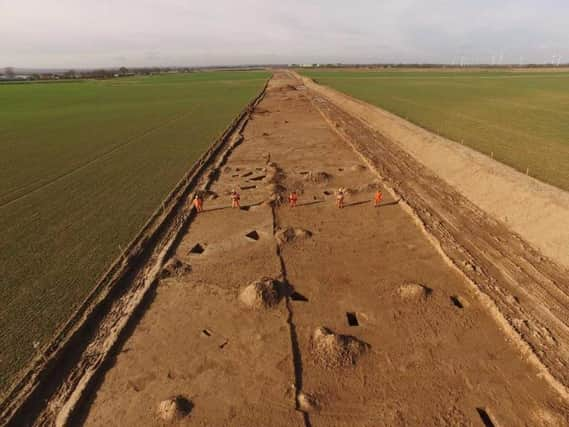Roman pottery among finds made by archaeologists working on cable route from world's largest offshore wind farm


Iron Age and Roman archaeology, including evidence of rural settlements, enclosures and field systems, have been found from Ulrome to near Cottingham 20 miles away.
Specialists from AOC Archaeology Group have been working their way southwards, carrying out extensive excavations, including at Ulrome and Beeford.
Advertisement
Hide AdAdvertisement
Hide AdAt Beeford they found some large Roman enclosure ditches, which usually surround settlements, as well as a “very significant” quantity of discarded Roman pottery, suggesting they were very close to a settlement.
They also found evidence for a roundhouse, a type of house with a circular plan, usually with a conical roof, which was the standard form of housing in Britain from the Bronze Age, through the Iron Age, and into the Roman period.
Stephen Potten, who manages AOC Archaeology’s York office and is leading the work, said: “One of the great advantages of doing a job like this is you get to see a whole landscape – not just a single archaeological site. The evidence we’ve unearthed suggests that the area was home to busy, thriving communities during the Iron Age and Roman periods.
“As well as pottery, a number of settlements have produced ironwork, animal bone and some evidence of industrial work too. This material helps us to understand what activities were taking place in the Iron Age and Roman periods, and how widespread they were.
Advertisement
Hide AdAdvertisement
Hide Ad“We’ve found some fantastic Roman pottery, often just discarded in ditches and pits. All these artefacts are now in the process of being cleaned and examined by specialists, who’ll be able to tell us if there are any unusual or rare forms and perhaps help us identify any high-status objects.
“It’s also possible some of the pottery was imported, and this could tell us a lot about trade links and commerce thousands of years ago.”
At Ulrome, a large circular feature picked up in earlier investigations turned out to be a pond which had been used for dumping pottery, dating from 700BC onwards.
Mr Potten said: “What it clearly has been used for is as a receptacle for dumping waste material, Iron Age and Roman pottery. We’ve also seen some evidence of industrial activity, some burned stones, fired clay, charcoal.
Advertisement
Hide AdAdvertisement
Hide Ad“We suspect they’ve been carrying out some form of industrial activity along the edge of the pond and dumping residues into the pond.”
Mr Potten said they needed specialists to examine the finds before they could come to any conclusions.
As many as 25 people have been working on the excavations and the work is set to continue into the New Year, with the finds eventually ending up at Beverley’s Treasure House.
Comment Guidelines
National World encourages reader discussion on our stories. User feedback, insights and back-and-forth exchanges add a rich layer of context to reporting. Please review our Community Guidelines before commenting.